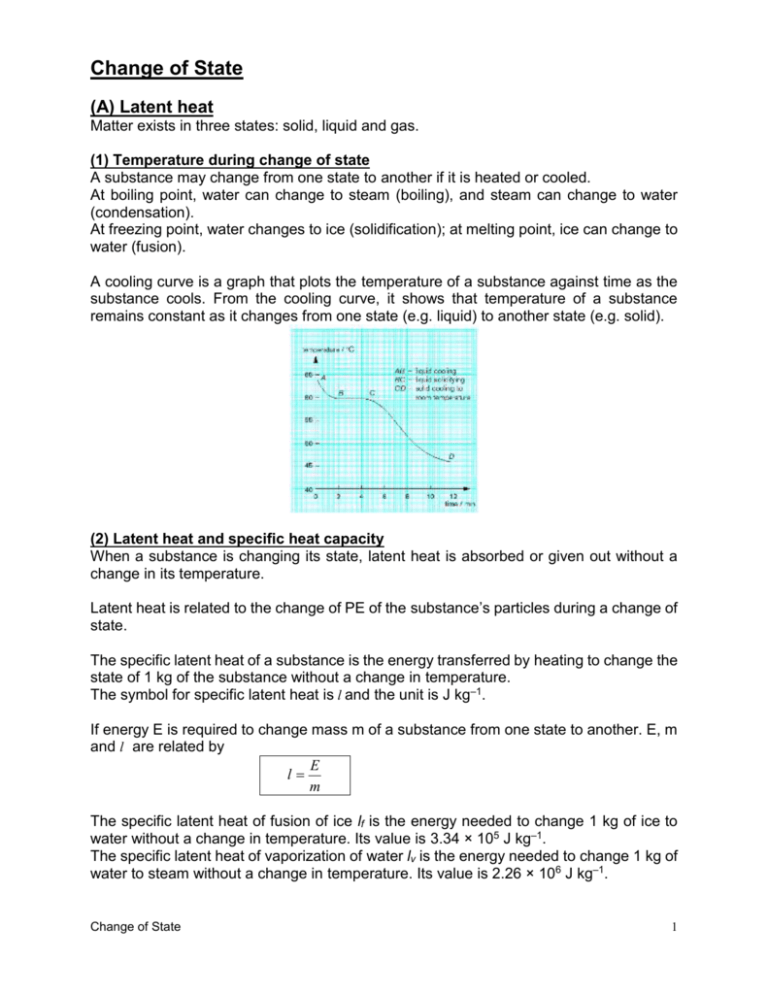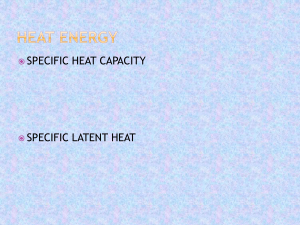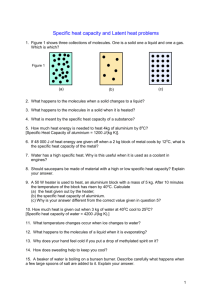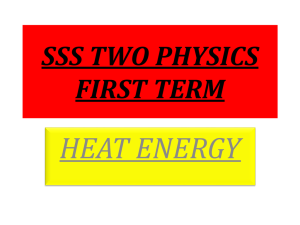Change of State
advertisement

Change of State (A) Latent heat Matter exists in three states: solid, liquid and gas. (1) Temperature during change of state A substance may change from one state to another if it is heated or cooled. At boiling point, water can change to steam (boiling), and steam can change to water (condensation). At freezing point, water changes to ice (solidification); at melting point, ice can change to water (fusion). A cooling curve is a graph that plots the temperature of a substance against time as the substance cools. From the cooling curve, it shows that temperature of a substance remains constant as it changes from one state (e.g. liquid) to another state (e.g. solid). (2) Latent heat and specific heat capacity When a substance is changing its state, latent heat is absorbed or given out without a change in its temperature. Latent heat is related to the change of PE of the substance’s particles during a change of state. The specific latent heat of a substance is the energy transferred by heating to change the state of 1 kg of the substance without a change in temperature. The symbol for specific latent heat is l and the unit is J kg–1. If energy E is required to change mass m of a substance from one state to another. E, m and l are related by E l m The specific latent heat of fusion of ice lf is the energy needed to change 1 kg of ice to water without a change in temperature. Its value is 3.34 × 105 J kg–1. The specific latent heat of vaporization of water lv is the energy needed to change 1 kg of water to steam without a change in temperature. Its value is 2.26 × 106 J kg–1. Change of State 1 The following figure shows the energy involved in heating 1 kg of water (from ice to steam). (3)Measuring specific heat capacity The specific heat capacity can be measured using the equation l Measuring specific fusion of water latent heat E . m of Measuring specific latent vaporization of water heat of Experiment al set-up l Calculation Precaution Possible source(s) of error E m l Before switching on the heater, pack the crushed ice in the two funnels such that the drip rates are steady and about the same. After switching off the heater, do not remove the cups; wait until the drip rates have become steady and about the same. A small piece of wire gauze or steel wool at the neck of the funnels can prevent the crushed ice from dropping into the beakers directly. Change of State Difficulty in keeping the water dripping down the two funnels at the same rate. Energy lost to the surroundings. E m Do not switch on the heater unless the heating part of it is totally immersed in water. Overheating in air may damage the heater. Steam condensing on the heater drips back into the cup. Energy is lost to the surroundings. 2 (B) Evaporation Evaporation is the changing of a liquid to a vapour which occurs at temperatures lower than the boiling point. Evaporation takes place at the surface of the liquid. Evaporation is related to the fast-moving particles escaping from the surface of a liquid. As fast-moving particles fly away, the average KE of the remaining particles is lowered; so the liquid becomes colder. This produces a cooling effect. Latent heat is required as the liquid evaporates. Water vapour in warm humid air condenses when the air is cooled. Latent heat is released as water vapour condenses (during condensation). Fast-moving particles in liquid escape and become vapour while slowmoving particles in vapour stick back to the liquid. The rate of evaporation (drying up) is the difference between the rate of escape and the rate of return. The rate of evaporation increases with • increasing temperature and surface area of the liquid, • decreasing density of vapour/humidity of air, and • increasing movement of vapour. The following table shows the comparison between evaporation and boiling. Evaporation Boiling Occurs at any temperature. Occurs at a definite temperature —the boiling point. Occurs at surface. Occurs within liquid. No bubbles formed. Bubbles appear. Change of State 3







